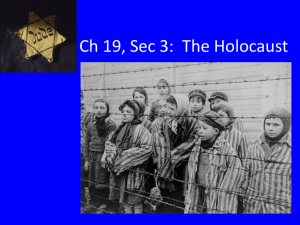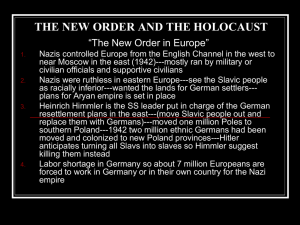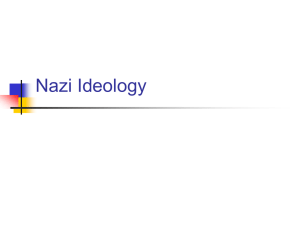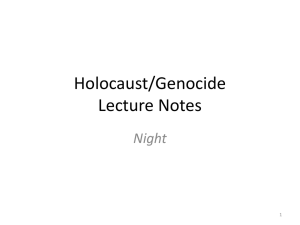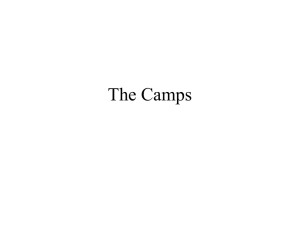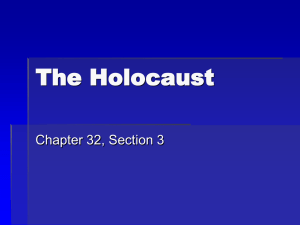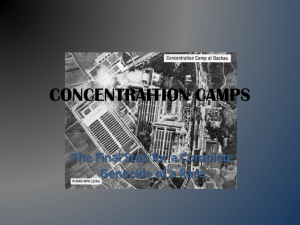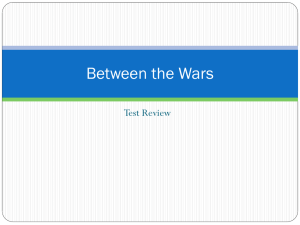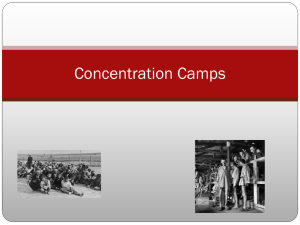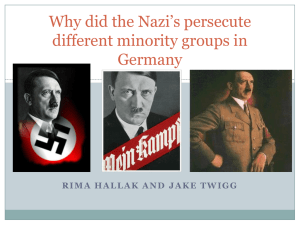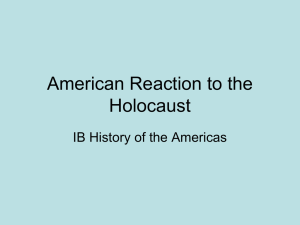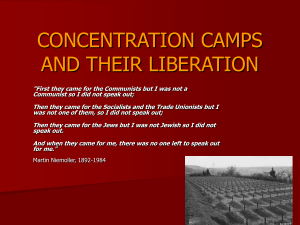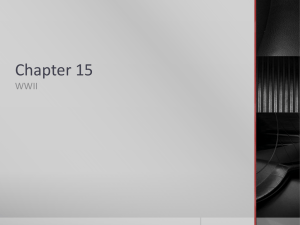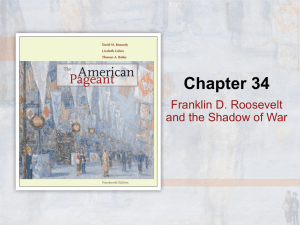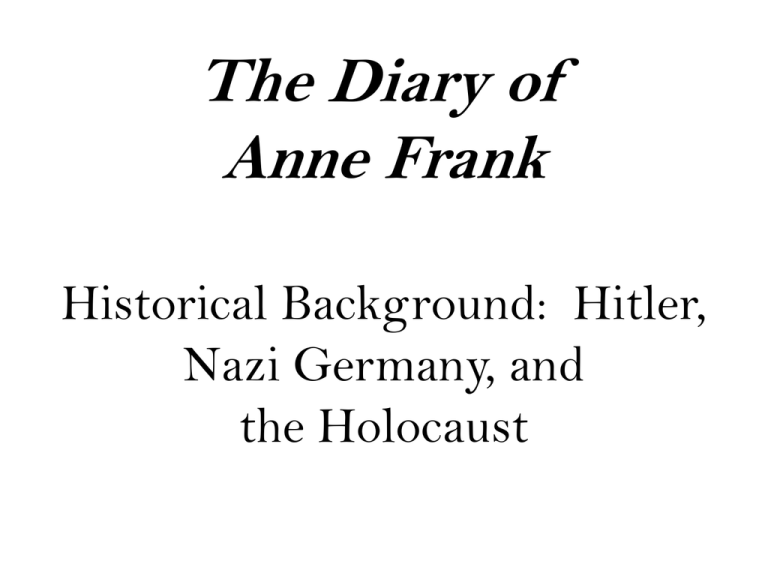
The Diary of
Anne Frank
Historical Background: Hitler,
Nazi Germany, and
the Holocaust
Germany Before World War II
• Germany lost World War I.
• Germany owed 30 billion dollars
to France in reparations.
• There was no money.
• There was no work.
• People lived in extreme poverty.
Here, the Salvation
Army serves hungry
Berliners in the dark
days of 1923.
The Rise of Adolf Hitler
• Adolf Hitler was a struggling art
student.
• He served as a corporal in World
War I; awarded Iron Cross for
bravery.
• He was jailed because his radical
political beliefs.
• He wrote his theories in a book
called Mein Kampf.
• He promoted extreme nationalism
(extreme patriotism).
• He was an exceptional speaker.
• He made Germans believe that he
could make things better from them.
The Aryan “race”
• pure German people, the Aryans, were the master race.
• Hitler believed that one of the reasons that Germany
lost WWI was because the German race had been
weakened through Aryans marrying non-Aryans.
Therefore, if Germany was to become strong again, the
Nazis had to ensure the purity of the Aryan race. This
view of Germans as the master race was encouraged by
the use of healthy, ‘pure’ Aryans in Nazi propaganda
posters.
“The Aryan race is tall,
long legged, slim. The
race is narrow-faced,
with a narrow forehead,
a narrow high built nose
and a lower jaw and
prominent chin, the skin
is rosy bright and the
blood shines through ....
the hair is smooth,
straight or wavy possibly curly in
childhood. The colour is
blond.” Description of a
‘pure’ Aryan. From a
leaflet ‘The Nazi Race’,
1929.
A boy and a girl used in a Nazi poster.
Jewish People as Scapegoats
• Hitler blamed the Jews for Germany’s
problems.
• The hatred of Jews is called anti-Semitism.
• The Jews became a scapegoat for
Germany.
• A scapegoat bears the blame for others and
is the object of irrational hostility.
Nazi Party
• The German Worker’s Party
• Nationalsozialistiche Deutsch
Arbeiterpartei
• Based on irrational, anti-Semitic and
nationalistic policies
• Membership grew in 1930s because
of propaganda and rallies
The Difference Between a Nazi and
a German
• A Nazi is a member of a political group that
no longer exists.
• A German is a person who lives in German
or was born in Germany.
• During World War II, not all Germans were
Nazis and not all Nazis were German.
Genocide
The deliberate and systematic destruction of a racial,
political, cultural or religious group.
The Holocaust
Holocaust: total destruction, usually by fire
The systematic, planned extermination of 6 million
Jews by the Nazis between 1933 and 1945.
Steps to Genocide
1. Segregation (Nuremberg Laws)
2. Isolation (Ghetto/Concentration Camp)
3. Persecution (Extermination Camp)
STEP 1: SEGREGATION
Identification
Jews were forced to
wear the Star of
David as part of the
Nuremberg Laws.
They were forced to
buy the stars and
wear them on their
coats/outer
clothing. This was a
form of segregation.
STEP 2: ISOLATION
Relocation to Ghettos
Jews were forced to move out of their homes and into ghettos.
A ghetto is a poor densely populated city district occupied by a minority ethnic group
linked together by economic hardship and social restrictions.
#2 definition from dictionary.com: a section of a city in which all
Jews were required to live
STEP 2: ISOLATION
Sent to Concentration Camps
The concentration camps were
established with different
purposes. For instance, there
existed “ordinary” concentration
camps, forced labor camps,
work- and reformatory camps,
POW camps and transit camps.
There were at least 22 main camps
distributed all over Germany and
Europe, more than 1,200 affiliate
camps and tens of thousands of
smaller camps. Many hundreds of
thousands of non-Jews and tens of
thousands of Jews perished in these
camps.
The concentration camps formed an important part
of the Nazi regime’s systematic suppression of
Jews, gypsies, political dissident, homosexuals and
other groups that were viewed as socially and
racially “undesirable” in the Nazi state.
Their common
denominator was the
fact that the living
conditions were
extremely horrible and
cruel for the inmates.
With very insufficient
food, the terrible
conditions resulted in
the deaths of an
enormous amount of
prisoners, especially in
the work camps.
STEP 3: PERSECUTION
November 9, 1938
First extreme acts of persecution.
Beginning of Hitler’s Final Solution (the attempted murder
of every Jewish person in Europe.
200 synagogues were destroyed.
8,000 shops were destroyed.
Thousands of Jews were sent to concentration camps.
Jews were forced to pay for all damage done.
STEP 3: PERSECUTION
Extermination Camps
Hitler’s Answer to the Jewish Question
This was his “Final Solution”
In the period of 1941-1945, for the first time in the history of
mankind, industrial plants were used to kill people. At the genocide
on the Jews, extermination camps were established, where the
Nazis in the most terrible way carried out the mass murder of 3
million Jews – half of the 6 million victims of the Holocaust.
STEP 3: PERSECUTION
Extermination Camps
Chelmo: This was the first extermination camp created with the one cruel purpose of
killing people – first of all Jews – in a systematic fashion. 152,000 people were killed by
gas at Chelmo.
Extermination Camps
• Chelmo
• Belzec
• Treblinka
• Sobibor
Concentration Camp AND
Extermination Camp
• Auschwitz-Birkenau
• Majdanek
Auschwitz – largest, killed 1-2 million people in gas chambers and crematoriums. 9 out
of 10 victims were Jews. The remaining victims were mainly Poles, gypsies, and Soviet
POW’s. Many were killed upon arrival to the camp.
The 6 extermination camps were all situated in former Poland. They were all situated
near railway lines, and they lay undisturbed in rural areas in “far away” Poland. They
were all situated far from “core” Germany and outside the spotlight of the German as
well as the international public.
http://www.holocaust-education.dk/lejre/udryddelseslejre.asp
One in 6 Million:
Why is Anne Frank so famous?
There are various reasons why Anne Frank is so
well-known.
1. The diary is so well-written. People all over the world
can identify with Anne.
2. She describes precisely what she thought and felt in
the secret annex, and what it’s like growing up. She
argues with her parents, falls in love, thinks about her
future… yet at the same time most readers know that she
did not survive the war, and that makes the diary very
dramatic. Her story of her life as well as her tragic death
also show how terrible the holocaust was.
3. It’s true that many other diaries have been published. But one thing that is
special about the diary of Anne Frank is that the place where it is was written
has been preserved, and also that there are many photos of her. As well as this,
Otto Frank worked tirelessly after the war to publicize the diary. Above all, the
diary of Anne Frank has become famous because of the stage play and the
film which were made of it.



